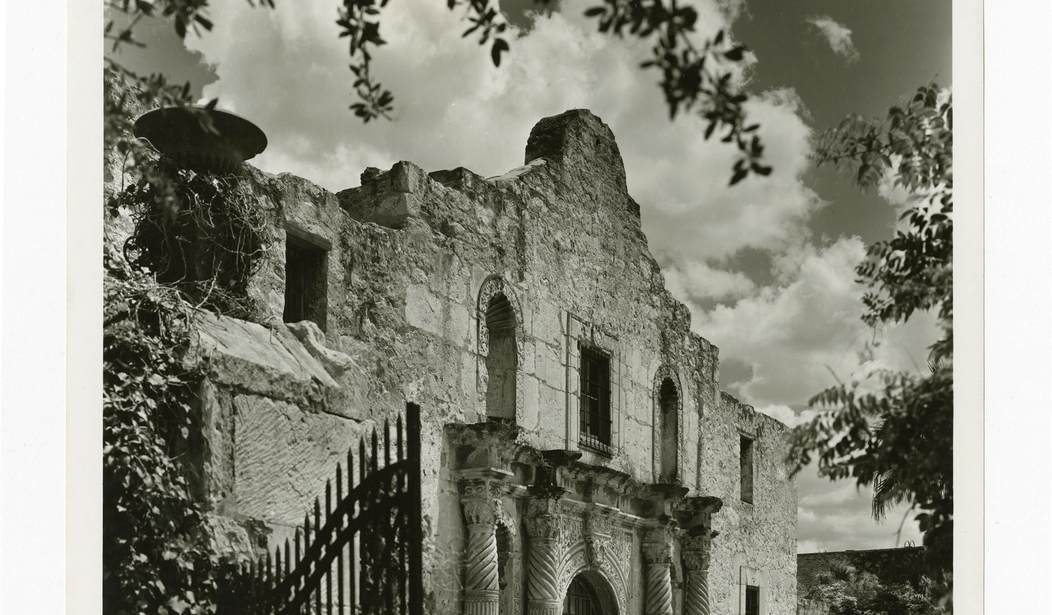Lately we’ve been subjected to an attempt to revise the history of Texas and in particular that of the Battle of the Alamo. There’s even a forthcoming book urging Texans to forget the battle of March 6, 1836, and the men who died there. That’s literally the title of the book, and a mischievous play on the San Jacinto battle cry “Remember the Alamo!”
The revisionist history is much like, and in fact imitates, the discredited 1619 Project, by which New York Times staff writer and not-a-historian Nikole Hannah-Jones rewrote America as being founded on slavery, not the ideals of the Declaration of Independence and the Constitution.
It’s an important debate, in that it stands to delegitimize the American government and self-image. Were we founded on a trajectory toward universal freedom, as the Declaration and Constitution say, or were we really founded on economic bondage and racism? If it’s the latter, July 4 loses all meaning and the American story is a lie. What were even the Greatest Generation heroes really fighting for? Ideals and liberty, or just some dirt and a piece of cloth they raised atop that little volcano in the middle of the Pacific?
So it goes in Texas, where woke history has taken over the Texas State Historical Association in the form of chief historian Dr. Walter Buenger, about whom I’ve written before, and this drive to get Texans to forget the Alamo and swap in a different one in which slavery was the cause of the war. Not independence from the tyrant Santa Anna and his centralist government, but slavery. Not even the ideals of the America that so many Texians of the time were born in and came to Texas from, but slavery. Economics, not beliefs or ideals, would have driven the Texas Revolution if this were true.
It is true, slavery existed in Texas at the time. Some but not all of the Texas leaders supported it. Not all Texans later supported secession from the United States, either, including Sam Houston, who won Texas’ independence at the Battle of San Jacinto.
It’s also true that abolitionists were in the then-Mexican state, and it’s also true that several Mexican states rose up against Santa Anna before Texas did and there were no slaves in those states. Those uprisings had nothing to do with slavery. Santa Anna had banned slavery, but then banned it again in 1837 — perhaps his previous ban didn’t stick. 1837 is after Texas won its independence, by the way, when it was its own republic modeled after the United States. There were also Asian slaves in colonial Mexico, which complicates the picture a bit. Real history is complex like that; woke history is jammed into neat little ideological boxes often with little regard for whatever the facts might say. A strong and valid critique of critical race theory and Marxism generally is its simple-mindedness.
With all of this in mind, let’s take a look at the list of Alamo defenders on the Alamo website. There is no official list, as some defenders will always remain unknown and unaccounted for. But this list is as official as it’s likely to ever get. By last count there were 189 defending the fort against Santa Anna’s assault. One of them was Amos Pollard. According to the Alamo list, Pollard was from Massachusetts and was 32 in 1836.
Amos Pollard, chief surgeon of the Alamo garrison, son of Jonas and Martha (Martin) Pollard, was born at Ashburnham, Massachusetts, on October 29, 1803. He was raised in Surry, New Hampshire, and graduated from the medical school of the Vermont Academy in Castletown, Vermont, in 1825. Pollard lived for a time in Greenbush, New York, and then spent the years 1825 to 1834 practicing medicine at various locations in Manhattan. He married Fanny Parker in 1828, and they had one daughter. His wife died in 1831. In 1834 Pollard traveled to Texas by way of New Orleans.
The Handbook of Texas sheds a bit more light on the life of Dr. Pollard.
He settled in Gonzales, Texas, and took part in the fight for the Gonzales ‘come and take it’ cannon, the opening skirmish of the Texas Revolution, on October 2, 1835. He later marched on San Antonio de Béxar as a private in Capt. John York‘s volunteer company. On October 23, 1835, he was appointed surgeon of the regiment by Stephen F. Austin.
After the siege of Bexar Pollard remained in the town as chief surgeon of the Texan garrison, on the staff of Lt. Col. James C. Neill. He cared for the sick and wounded of the garrison and also set up a hospital within the Alamo.
Neill departed the Alamo to tend to his sick family, leaving command in the hands of Lt. Col. William Barret Travis and Jim Bowie, who later fell gravely ill. Pollard would have cared for Bowie during the siege. We know he never left the Alamo.
What did Pollard believe and what was he fighting for?
He told the world exactly what he believed in a letter he wrote in 1835 that was published in The Liberator. William Lloyd Garrison, the principled, radical, and fiery abolitionist, published The Liberator out of New York. He detested slavery. Pollard wrote a letter from Texas on February 15, 1835, to Garrison, that Garrison published in May that year. I have a scan of his letter in my files. In that letter, Pollard said:
Dear Sir,
Although I have not a personal acquaintance with you, being animated with similar feelings, I take the liberty of thus addressing you.
The “similar feelings” animating Pollard and Garrison were about slavery: both men hated it and wanted it abolished. Pollard continued that he wanted Texas to be settled with “friends of freedom” and had a strategy in mind to make that happen.
Texas is now settling extremely fast, mostly from the Western and Southern States, because it is more known in those States; but let the people of the Northern and Eastern States only have the correct information concerning the interesting, rich, and prospectively great country, and they will pour in here in torrents, leaving the slave-holders shortly in a minority. The Constitution of Mexico precludes slavery, yet it is evaded by having the blacks indentured for ninety-nine years, &c.
He’s both asking Garrison to play up emigrating to Texas to outnumber slaveowners, and speaking on the flaw in Santa Anna’s “abolition” of slavery.
After describing how wonderful Texas is, and he makes a convincing case, Pollard writes:
I am very anxious to see an end put to slavery in all parts of the world, and especially that it may be prevented from taking deep root in Texas.
He closes the letter noting that he is from Massachusetts and has practiced medicine in Boston and New York, signing it “Amos Pollard, M.D.,” so we know this is the same Amos Pollard who died as the chief surgeon at the Alamo on March 6, 1836.
Pollard’s motives are made clear and beyond doubt in the letter published in the anti-slavery newspaper The Liberator nearly a year before the fateful battle. In fact, Pollard wrote that letter before the war in Texas had broken out. Not only was he not fighting for slavery, the educated Dr. Pollard was expressly fighting in Texas, in three known battles, to kill slavery and for freedom.
This complicates the “Alamo was about slavery and whiteness” narrative quite a bit, does it not?









Join the conversation as a VIP Member